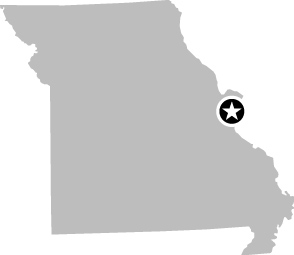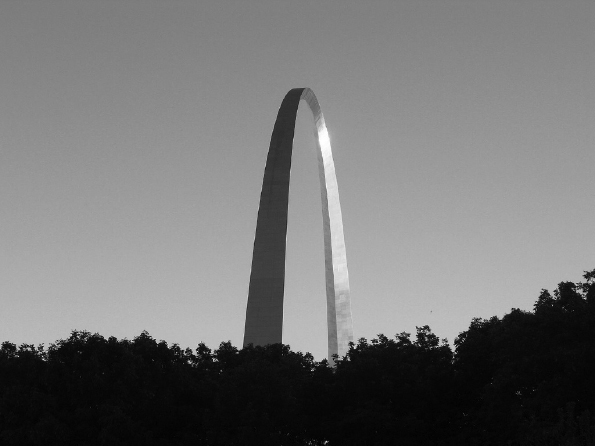Missouri
103
Gateway Arch, St. Louis, MO
 38° 37′ 28.81″ N, 90° 11′ 5.82″ W
38° 37′ 28.81″ N, 90° 11′ 5.82″ W
![]()
![]()
![]()
Gateway to the West
The Gateway Arch in St. Louis, Missouri, stands at 192 meters, and is the tallest monument in the U.S. (Figure 103-1). It was opened in 1967, and the view from the top is spectacular. The top is reached by riding in small five-person trams that travel up the legs of the arch to the observation deck at the top. While you’re up there, you can contemplate the perfect shape of the arch—it’s a catenary.

Figure 103-1. The Gateway Arch; courtesy of Pat Dye (gobucks2)
Even though the arch is man-made, there’s something natural-looking about it, because a catenary is a shape made simply by the force of gravity. Take a short piece of rope (or string, or a necklace of uniform thickness) and hold one end in each hand. With your hands level, the rope falls into a graceful curve under its own weight pulled down by gravity. That shape is a catenary (a term coined by Thomas Jefferson based on the Latin word for chain), and the weight of the rope is transmitted by tension through the rope itself.
Invert a catenary and build it out of something rigid, and you’ve got a catenary arch. The Gateway Arch is one example, but catenary arches are very common. They’ve been built since antiquity because they are stable—the weight of the arch’s components acts downward through the arch’s legs.
The arch follows the shape of a catenary curve and is constructed from stacked metal equilateral triangles. The centroid of each of the triangles is aligned with the curve being followed; the triangles start out at the bottom with 16-meter sides that narrow to 5 meters at the top. This narrowing explains why the trams are so small—you should be grateful that they’re there at all, though, because the original plan was to have visitors walk 1,076 steps to the top.
The exterior of the Gateway Arch is made of plates of stainless steel that cover 90 meters of reinforced concrete, topped by a steel structure that completes the shape. Because the arch curves, the trams are mounted on gimbals that allow them to stay level as they climb the curved interior of the legs.
The arch is as high as it is wide, and it weighs about 15,600 tonnes. It sways in the wind up to a maximum of close to 50 centimeters in each direction; on very windy days, the observation area is closed.
At the base of the arch is a visitor center that explains its construction and a little of the mathematics behind its shape. There’s also the Museum of Westward Expansion, which explains the Lewis and Clark expedition that helped open up the western U.S., and also covers the Louisiana Purchase and the debate over slavery. The arch is sometimes called the Gateway to the West.
The arch is part of the Jefferson National Expansion Memorial, a 37-hectare park along the Mississippi River. Once you’ve spent a couple of hours seeing the arch inside, and the associated museum, the park makes an ideal spot for a walk, lunch, or bike ride. It’s also possible to take helicopter tours of St. Louis for an aerial view of the arch from all angles.
Practical Information
Visiting information (and, I promise, no calculus—unlike the upcoming sidebar) is available from http://www.gatewayarch.com/.






